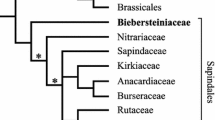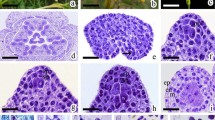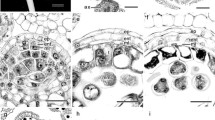Abstract
Scilla persica and 5 species of the so-calledS. hohenackeri group, namely,S. furseorum, S. puschkinioides, S. vvedenskyi, S. hohenackeri, andS. greilhuberi, have been investigated embryologically with special reference to embryo sac and endosperm development.Polygonum-type embryo sac development was stated inS. puschkinioides andS. greilhuberi. 8-nucleate, normally structured embryo sacs, which could not be specified further due to sparse availability of the material, were stated inS. furseorum, S. vvedenskyi, andS. hohenackeri. InS. persica the embryo sac develops according to the bisporicAllium-type. In most species endosperm development was stated to be nuclear, exceptS. hohenackeri, where the type could not be specified. Other traits of possible taxonomic significance are the number of layers in the outer integument, which is mostly 4, or 5–6 inS. furseorum, and the occurrence of polyploid versus haploid and early degenerating antipodal nuclei, the latter occurring only inS. persica andS. furseorum. These embryological characters may be useful for assessing taxonomic relationship of the present species with other allied groups withinScilla, in particular, theS. siberica alliance,S. messeniaca, and theS. bifolia alliance. TheAllium-type embryo sac, which occurs inS. persica, is also characteristic for theS. siberica alliance, and may be a common derived character. Lack of antipodal polyploidization, as characteristic forS. persica andS. furseorum, occurs also in theS. siberica alliance, and is perhaps another common derived trait indicating phylogenetic relationship. Nuclear endosperm development is more frequent in spring-flowering squills than helobial development, which has previously been stated inS. messeniaca, some species of theS. siberica alliance, and inS. litardierei. While helobial endosperm may be primitive forHyacinthaceae in general, it may, by reversal, also occur as a derived character, at least in some species of theS. siberica alliance.
Similar content being viewed by others
References
Dahlgren, R., Rasmussen, F. N., 1983: Monocotyledon evolution: characters and phylogenetic estimation. — Evol. Biol.16: 255–395.
Ebert, I., Greilhuber, J., Svoma, E., Speta, F., 1983: Taxonomic significance of embryology inScilla. — Acta Bot. Neerl.32: 356–357.
Greilhuber, J., 1977: Nuclear DNA and heterochromatin contents in theScilla hohenackeri group,S. persica, andPuschkinia scilloides (Liliaceae). — Pl. Syst. Evol.128: 243–257.
—, 1984a: Chromosome evidence in taxonomy. — InHeywood, V. H., Moore, D. M., (Eds.): Current concepts in plant taxonomy. — Systematic Ass. Special Vol.25: 157–180. — London, Orlando: Academic Press.
- 1984b: Functional and evolutionary aspects of constitutive heterochromatin in plants. — InDryanovska, O. A., (Ed.): Third national conference on cytogenetics; pp. 59–69. — Bulgarian Academy of Sciences.
—, 1976: C-banded karyotypes in theScilla hohenackeri group,S. persica, andPuschkinia. — Pl. Syst. Evol.126: 149–188.
Hennig, W., 1950: Grundzüge einer Theorie der phylogenetischen Systematik. — Berlin: Deutscher Zentralverlag (reprint 1980 by Otto Koeltz Science Publishers, Koenigstein, Federal Republic of Germany).
Herr, J. M. jr., 1971: A new clearing-squash technique for the study of ovule development in angiosperms. — Amer. J. Bot.58: 785–790.
Johansen, D. A., 1950: Plant embryology. — Waltham, Mass.: Chronica Botanica Company.
Meikle, R. D., 1966a:Scilla persica. — Curtis's Bot. Mag. N.S.176: t. 486 + 3 pp.
- 1966b:Scilla furseorum. — Curtis's Bot. Mag. N.S.176: t. 507 + 3 pp.
Speta, F., 1974:Scilla messeniaca Boiss. (Liliaceae) und ihre verwandtschaftlichen Beziehungen. — Ann. Mus. Goulandris2: 59–67.
—, 1980: Die frühjahrsblühendenScilla-Arten des östlichen Mittelmeerraumes. — Naturkundl. Jahrb. Stadt Linz25: 19–198, tt. I–XXXI, 1–16.
Svoma, E., 1981: Zur systematischen Embryologie der GattungScilla L. (Liliaceae). — Stapfia9: 1–124.
-Greilhuber, J., 1984: Neue Ergebnisse zur systematischen Embryologie in der GattungScilla (Hyacinthaceae). — InEhrendorfer, F., (Ed.): Mitteilungsband Botaniker-Tagung 1984, p. 99. — Wien.
- - 1988: Systematic embryology of theScilla siberica alliance (Hyacinthaceae). — Nordic. J. Bot.8 (in press).
Wiley, E. O., 1981: Phylogenetics. — New York, Chichester, Brisbane, Toronto: John Wiley & Sons.
Wunderlich, R., 1937: Zur vergleichenden Embryologie derLiliaceae-Scilloideae. — Flora132: 48–90.
—, 1959: Zur Frage der Phylogenie der Endospermtypen bei den Angiospermen. — Österr. Bot. Z.106: 203–293.
Author information
Authors and Affiliations
Rights and permissions
About this article
Cite this article
Svoma, E., Greilhuber, J. Studies on systematic embryology inScilla (Hyacinthaceae). Pl Syst Evol 161, 169–181 (1988). https://doi.org/10.1007/BF00937297
Received:
Issue Date:
DOI: https://doi.org/10.1007/BF00937297




